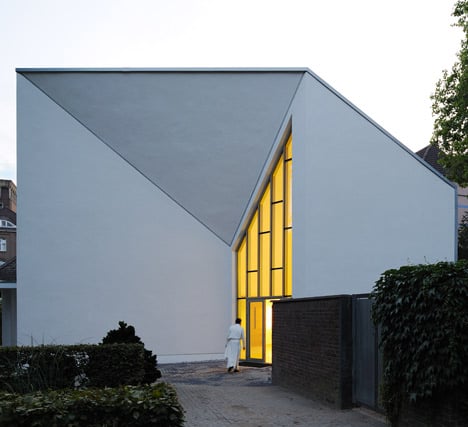
Hamborn Abbey Extension by Astoc
German architects Astoc have completed a monastery extension in Duisburg with walls that fold around the entrance like origami sculptures.
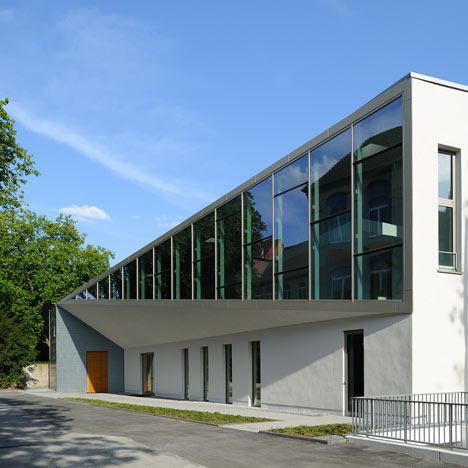
Hamborn Abbey was consecrated in the twelfth century and has been altered many times in its history.

The recent addition is faced in white plaster and creates a third edge around a private courtyard garden.

A large triangular window projects proud of one elevation, while a glass wall at the entrance recedes into the facade.
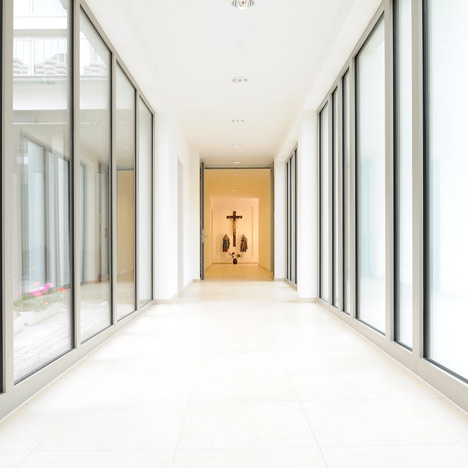
Tiles cover the sloping roof of the monastery and wrap around a wall at the far corner.
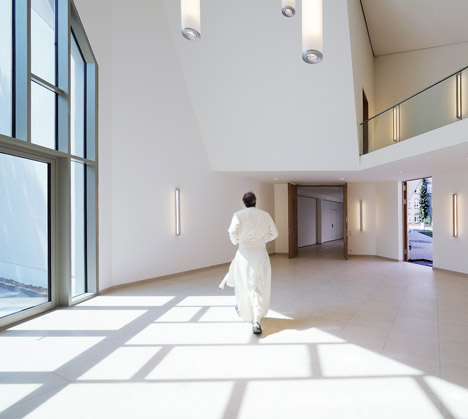
The new building includes a church for choral prayers and a refectory for communal meals.
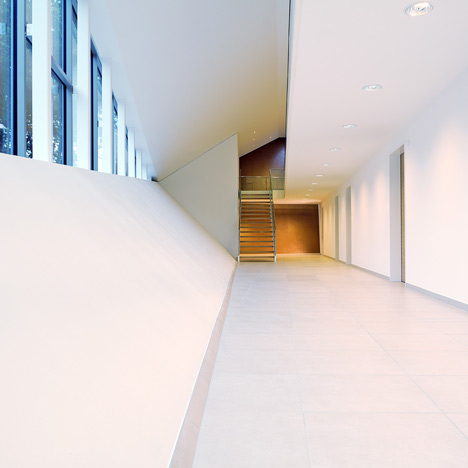
Other buildings for worship from the Dezeen archive include a church perforated by stained glass panels and a temple in Mumbai.
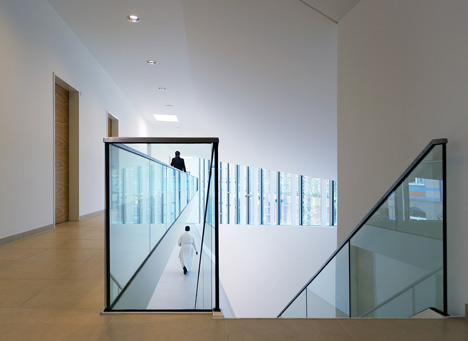
Photography is by Christa Lachenmaier.
Here are some more details from Astoc:
Extension of Hamborn Abbey, Duisburg
It may come as a surprise to find a flourishing catholic monastery in the midst of an industrial city like Duisburg. The urban district of Hamborn is, however, rather different from the ones dominated by withering heavy industry. The site of the present St. Johann Abbey in Hamborn was already settled more than a thousand years ago. The beginnings of its ecclesiastical history are marked by the donation of the Hamborn estate to the archbishop of Cologne in 1136 with the condition to build a monastery there. The small parish church, already existing on the estate since the ninth century, was subsequently converted to a monastery church. A Romanesque cloister was added to link the various buildings of the abbey with each other of which the northern wing still exists today. The monastery church was consecrated in 1170, elevating it to the status of an abbey. That title was annulled in 1806 in the course of the secularization drive. During World War Two, the buildings were largely destroyed but, as if in defiance, resettled by seven brothers in 1959. In 1994, the building complex regained the status of an abbey. In 1972, a three-storied extension was added to provide residential and office space, designed by the Cologne-based architect Hans Schilling.
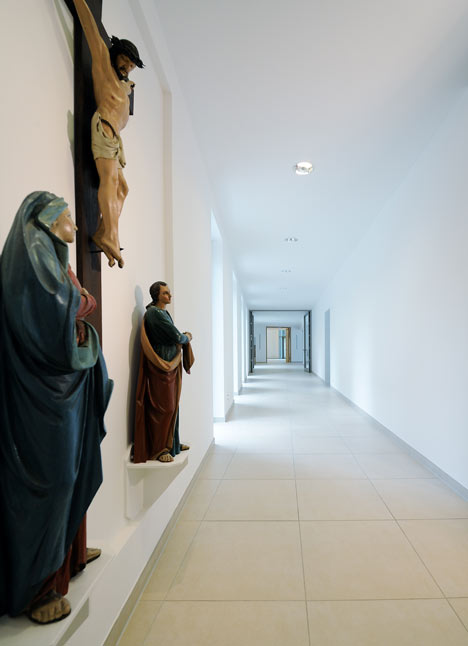
Today, twenty-five canons are part of the abbey. As the order in Hamborn keeps growing each year, another building extension was required. The client wanted the architecture' to express one of the typical ideals of a canonical monastery, namely that of "communio ad intra et ad extra" ("community inside and community outside). ASTOC’s design follows the principles of the Premonstratensians who consciously and deliberately combine monastic community life with pastoral and missionary service, building communities both within and outside the abbey.
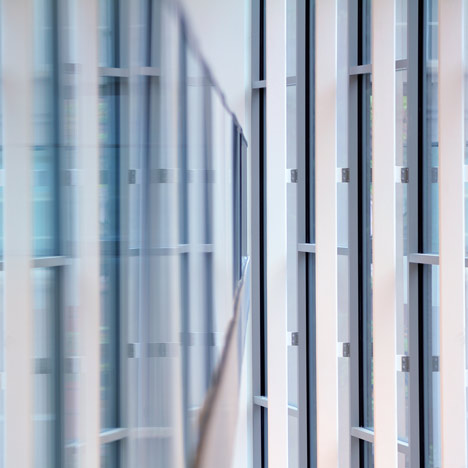
The new oblong building closes the gap on the third side of a courtyard garden which was previously enclosed only on two sides. With it, a self-confident and new contemporary quality has been added to the heterogeneous buildings in the neighborhood. The new building adopts the principle of employing columns to line the corridor areas, as is the case with the medieval southern wing and the extension designed by Hans Schilling. The irregular geometry of the white-plastered new building appears folded. The folds allow the building to subtly react to the urban developmental and geometrical guidelines that are derived from the shape of the site and the connecting heights of the existing buildings surrounding it.
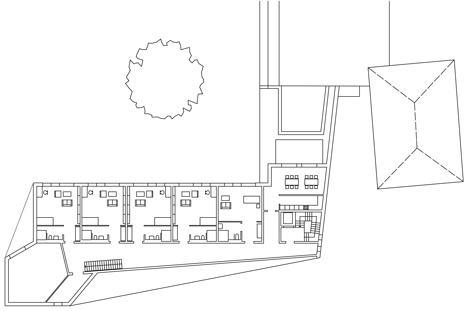
The spaces inside the new building satisfy all the requirements of monastic community life which includes joint meals in the refectory and choral prayers in the monastery church, requiring places and spaces to meet and communicate, as well as those for silence and worship. The Premonstratensians combine the inner life of the monastic community with outwardly directed pastoral care. This is also evident in Hamborn: just next door is the abbey high school, the abbey center for seminars and conferences, St. John’s Hospital, and the abbey cemetery which are all imbedded in the old vicarage of St. Johann and the neighboring vicarages that are also performance venues of the canons.
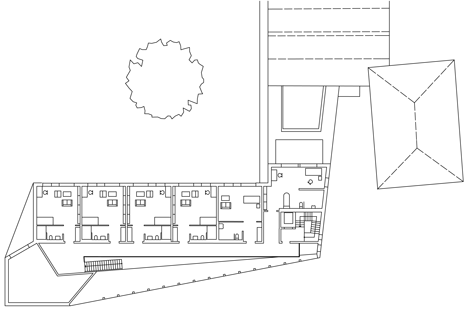
Apart from the residential wing, the new building provides a sacral chamber, offices and a recreation room with large doors that give onto the garden, the conversation and group spaces, terraces, and the patio. The different functions are all housed under one common roof while the spaces are organized around liturgical paths, each with their own distinct architecture: on the first floor, an historical crucifixion group visually leads on to the extension building, guiding the eye and subsequent movement in space.
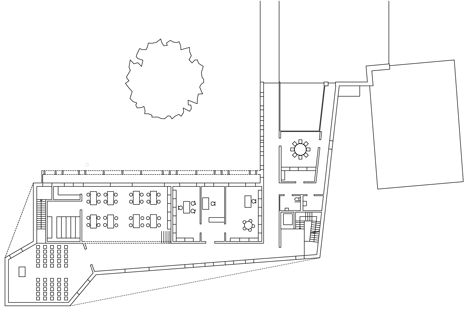
Coming from the existing buildings, the path leads from the Romanesque cloister (and from the monastery church) to the chapel at the narrow end of the oblong building. This small, vertically rising sacral space, equipped with its own gallery, faces the east, permitting morning light during the early morning prayers. In keeping with the premise of intimately linking inside and outside, the chapel can be accessed from three sides: from the inside of the monastery, from the cemetery and from the street or the neighboring school. It can also be used for funeral services, for group services with school classes or for days of retreat. As such, the entire monastery complex is positioned between two sacral spaces that are connected with each other and to the monastery by the cloisters.
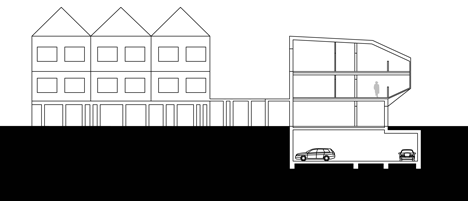
The two upper floors are more private in nature. Here, the bowers are lined along a double-story inner pergola. A golden front wall serves as optical apex of the dynamically-shaped diagonal surfaces that describe the space.
While the new building continues the neighboring building’s row of columns on the garden side, it presents a distinct and different look to the street side, with its white-plastered facades starkly contrasting the reddish brown brick of the neighboring building. The new building has a flat pent roof and is dipped in a warm antique white hue both on the inside and the outside, bringing to mind the color of the Premonstratensian order’s robes. The white surfaces are complemented by oak doors and floors, coated concrete, and the metal and glass facade of the entrance side.
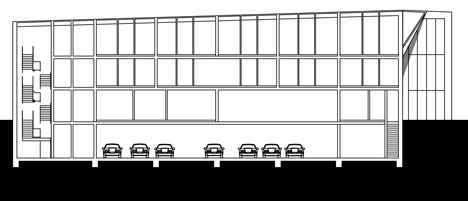
The extension building is brightly lit, being suffused by light, understood as symbol of “the Premonstratensians’ commitment to the testimonial of life”, as Abbot Albert puts it. In all their actions, they strive to affirm life which the resurrected Christ contrasts with the darkness of death.